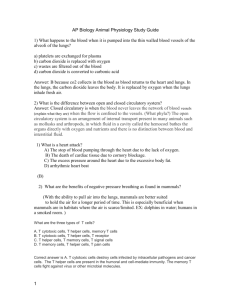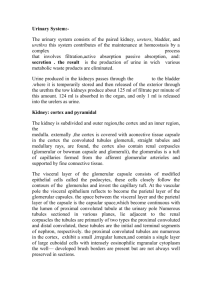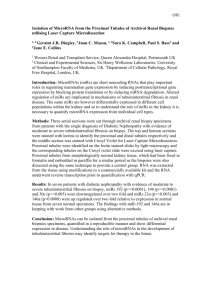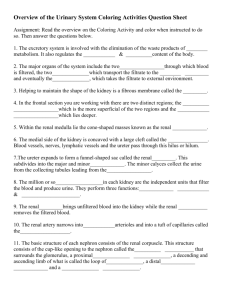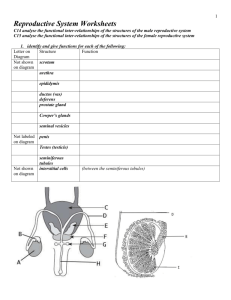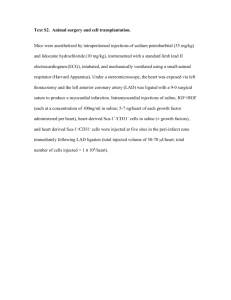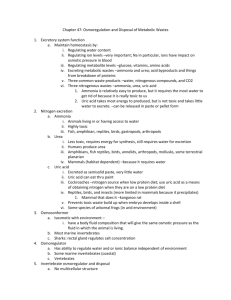Active Transport in Insect Malpighian Tubules
advertisement
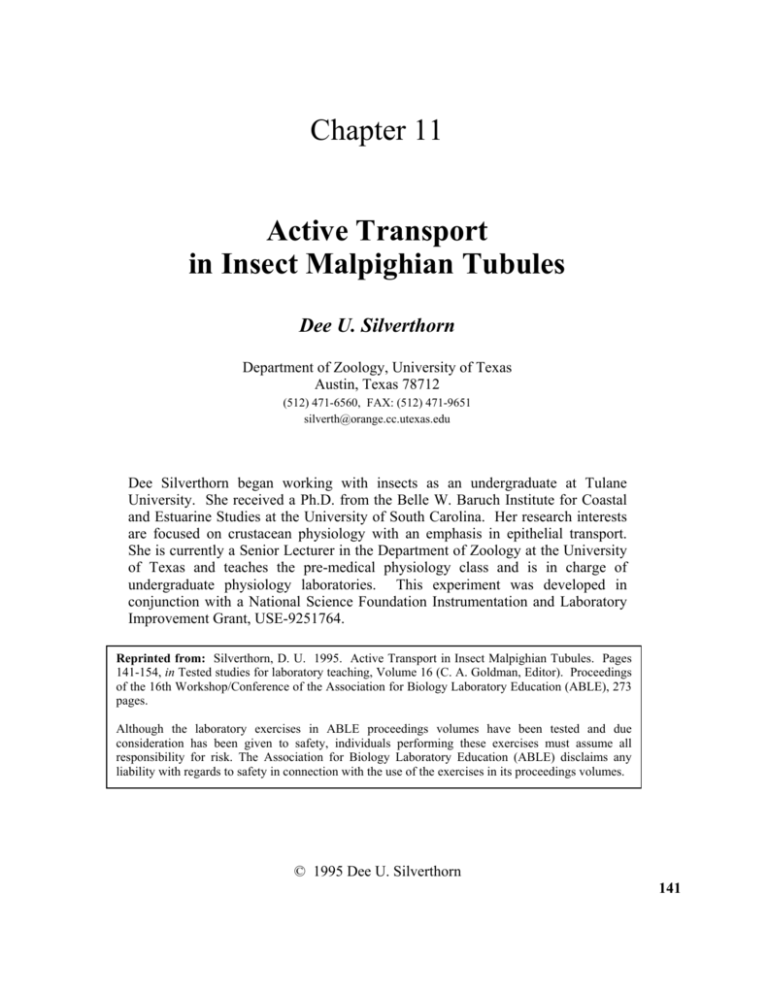
Chapter 11 Active Transport in Insect Malpighian Tubules Dee U. Silverthorn Department of Zoology, University of Texas Austin, Texas 78712 (512) 471-6560, FAX: (512) 471-9651 silverth@orange.cc.utexas.edu Dee Silverthorn began working with insects as an undergraduate at Tulane University. She received a Ph.D. from the Belle W. Baruch Institute for Coastal and Estuarine Studies at the University of South Carolina. Her research interests are focused on crustacean physiology with an emphasis in epithelial transport. She is currently a Senior Lecturer in the Department of Zoology at the University of Texas and teaches the pre-medical physiology class and is in charge of undergraduate physiology laboratories. This experiment was developed in conjunction with a National Science Foundation Instrumentation and Laboratory Improvement Grant, USE-9251764. Reprinted from: Silverthorn, D. U. 1995. Active Transport in Insect Malpighian Tubules. Pages 141-154, in Tested studies for laboratory teaching, Volume 16 (C. A. Goldman, Editor). Proceedings of the 16th Workshop/Conference of the Association for Biology Laboratory Education (ABLE), 273 pages. Although the laboratory exercises in ABLE proceedings volumes have been tested and due consideration has been given to safety, individuals performing these exercises must assume all responsibility for risk. The Association for Biology Laboratory Education (ABLE) disclaims any liability with regards to safety in connection with the use of the exercises in its proceedings volumes. © 1995 Dee U. Silverthorn 141 142 Active Transport Contents Introduction....................................................................................................................142 Materials ........................................................................................................................142 Student Outline ..............................................................................................................143 Notes for the Instructor ..................................................................................................149 Acknowledgements........................................................................................................152 Literature Cited ..............................................................................................................152 Appendices.....................................................................................................................153 Introduction This laboratory exercise uses insect Malpighian tubules to demonstrate transport processes in a living tissue. It does not require complicated equipment and depends on visual assessment of dye concentration. By varying the solutions in which the Malpighian tubules are incubated students can show the energy dependence of active transport as well as the properties of specificity, competition, saturation, and inhibition. Since transport of the dye chlorophenol red across an epithelium is a complex mechanism involving several different membrane transport proteins, students who have not been introduced to indirect active transport processes (also known as secondary active transport) may need additional instruction in this area. The accompanying Student Outline is designed for a lower-level laboratory in which the students are provided with a series of previously prepared solutions. In a more investigative laboratory students design their own experiments and make up their own solutions from 10X stocks. Setup time for the laboratory is 2–3 hours and consists mainly of making solutions. The laboratory exercise itself requires a 3-hour block of time. When the exercise is done as an investigative project students repeat the project in three successive weeks. This allows extra time for them to make their own solutions and to run replicate experiments for statistical analysis. We have used both crickets and roaches successfully for this experiment. Students are less squeamish about handling crickets. Roaches have a large amount of fat body in the abdomen that must be removed during the dissection and this slows down the experiment when students are running duplicates. Materials Large adult crickets (Acheta domestica) or cockroaches (Periplaneta or Blaberus) (8–10/group) Test tubes large enough to hold insects (1–2/group) Ice buckets, tubs or 1 liter beakers to use as ice containers (1/group) Dissecting microscope with light (1/group) Dissecting pans that fit under microscope (1/group) Petri dishes, 35 mm (4/group) Fine insect pins (4/group) Fine point forceps (1–2/group) Spring-handle fine dissecting scissors or other fine point scissors (1/group) Blunt glass or metal probes Pipet pumps for up to 10 ml (1/group) Pipets, 5 or 10 ml (10/group) White paper to put behind petri dishes or white ceramic spot plates (1/group) Pasteur pipets and bulbs (24/group) Latex surgical gloves (1 pair/student) Grease pencil or marker and tape for labelling (1/group) Active Transport 143 Kimwipes (1/group) Plastic wrap or foil to cover test tubes (1/class) Fine silk thread for ligating roach intestine, optional (1 spool/class) For preparation of the solutions: Balance (1/class unless students make their own solutions) pH meter (1/class unless students make their own solutions) Erlenmeyer flasks with stoppers or other storage containers (7/class) Volumetric flasks Solutions Insect saline in a closed flask (150 ml/group) 1 mM chlorophenol red in saline (25 ml/group) 1 mM chlorophenol red + 0.1 mM 2,4-DNP in saline (25 ml/group) 1 mM chlorophenol red + 10 mM ouabain in saline (25 ml/group) 1 mM chlorophenol red + 0.1 mM 2,4-DNP + 10 mM ATP in saline (25 ml/group) 1 mM chlorophenol red + 10 mM PAH in saline (25 ml/group) 1 mM chlorophenol red in zero potassium saline (25 ml/group) 1 mM chlorophenol red in zero sodium saline (25 ml/group) Student Outline Introduction In this experiment you will be using the isolated Malpighian tubules of insects to study secretion of organic molecules across a transporting epithelium. This experiment demonstrates the effect of metabolic inhibitors, competitors, and ions on the transport of organic dyes such as chlorophenol red. The transporting tubules of excretory systems are remarkably similar in animals as diverse as insects and mammals. The Malpighian tubules of insects are finger-like extensions of the intestinal tract. The proximal ends of the tubules are attached to the intestine at the junction of the midgut and hindgut while the closed distal ends float free in the hemolymph (blood) of the insect. Excretion is achieved exclusively by secretion of ions and organic molecules from the hemolymph into the lumen of the tubule (Figure 11.1). This is unlike the mammalian kidney, where most of the contents of the kidney tubule derive from plasma filtered into the lumen at Bowman’s capsule. As in the mammalian kidney, however, the contents of the lumen are modified as they pass through the Malpighian tubule and hindgut. The walls of the Malpighian tubule are composed of a single layer of cuboidal epithelial cells. These cells rely heavily on active transport mechanisms to concentrate ions and organic molecules in the lumen. Since the individual tubules are not bound together, they make an excellent study system in which you can examine some of the properties of secretion in a transporting epithelium. You will be using Malpighian tubules from crickets or cockroaches. When incubated with chlorophenol red, a colored organic anion, the tubules actively transport the dye into the lumen against a concentration gradient. The amount of dye being transported can be estimated visually. Since active transport is energy-dependent and uses a protein carrier, the accumulation of dye will have the same properties as other protein-based mediated transport systems: saturation, competition, and specificity. 144 Active Transport Figure 11.1. Fluid is secreted from the hemolymph (blood) into the lumen of the Malpighian tubule. Bulk flow and wave-like contractions push the secreted fluid out of the tubule into the gut. The transport systems of the Malpighian tubule include several types of indirect active transporters. These are membrane proteins that utilize the energy of one molecule moving down its concentration gradient in order to move a second molecule against its concentration gradient. The sodium-glucose transporter of the mammalian kidney is a typical example. The transporter uses the energy of sodium entering the cell down its concentration gradient to bring glucose into the cell against its gradient. Both molecules move into the cell on the same transport protein. The cotransport of sodium and glucose is termed indirect active transport because it uses the potential energy of the sodium gradient to push glucose against its gradient. Direct active transport uses energy stored in the high-energy bond of ATP. Another major transport protein of the tubule + + epithelium is the Na /K -ATPase (sodium-potassium pump), located on the extracellular fluid face of the cells. This pump maintains the sodium gradient between the cells and the extracellular fluid by removing Na+ from the cell in exchange for K+. Activity of the pump requires energy from ATP. In the absence of ATP or if the pump is poisoned by metabolic inhibitors such as ouabain, sodium leaks into the cell and the sodium gradient slowly disappears. Without the potential energy stored in the sodium gradient, indirect active transport processes such as the sodium-glucose co-transporter are unable to function. Renal transport systems for organic anions such as chlorophenol red depend on indirect active transport proteins. Although the system has not been well-studied in insects, the membrane proteins appear to be very similar to those involved in transepithelial organic anion transport in mammals. A list of the compounds and drugs known to be transported by the organic anion system of the vertebrate kidney is shown in Table 11.1. Figure 11.2 shows the current model for organic anion transport in mammals (Grantham and Chonko, 1991). Organic anions such as chlorophenol red are moved from the extracellular fluid (ECF) into the tubule cell in exchange for a dicarboxylate such as α-ketoglutarate (αKG) or glutamate. The organic anions then move out of the cell into the lumen by indirect active transport, exchanging for another anion such as chloride, hydroxyl, or urate. The cell maintains a supply of αKG by importing it from the ECF along with Na+ ions. The concentration gradient for sodium is maintained by the ATP-dependent sodium-potassium pump. This membrane transporter pumps sodium out of the cell and potassium into the cell. Thus the transepithelial transport of organic anions such as chlorophenol red from the ECF into the lumen of the kidney is a two-step process: import into the tubule cell in exchange for a dicarboxylate followed by export into the lumen in exchange for another anion. Active Transport 145 Table 11.1. Some compounds secreted by the renal organic anion transport systems (adapted from Grantham and Chonko, 1991). Endogenous compounds Drugs Amino acids Bile salts Cyclic AMP Oxalate Prostaglandins Benzoate Hippurate Furosemide Penicillin Probenecid Saccharin Salicylate Chlorothiazide Acetazolamide Fluoresceinate Figure 11.2. Model of organic anion transport in the mammalian kidney. (1) Chlorophenol red (CPR) and other organic anions such as PAH are transported into the tubule cell from the extracellular fluid by exchange with a dicarboxylate such as α-ketoglutarate (αKG) or glutamate. The CPR moves out of the tubule cell and concentrates in the lumen in exchange for an anion such as chloride or hydroxyl. (2) αKG is concentrated in the tubule cell by indirect active transport. The movement of αKG into the cell against its concentration gradient is accomplished by linking it to the movement of Na+ down its concentration gradient. (3) The cell maintains concentration gradients for sodium and potassium by using the ATP-dependent sodium-potassium pump. This membrane transporter, also known as the Na+/K+-ATPase, pumps sodium out of the cell and potassium into the cell. In the absence of ATP or the presence of ouabain the pump stops and the sodium concentration gradient gradually disappears. You will be adding your test solutions to the hemolymph or ECF side of the tubule. Insects have an open circulatory system, so the ECF side in Figure 11.2 is equivalent to the hemolymph in 146 Active Transport insects. The saline solutions you will use in this experiment are shown in Table 11.2. All contain chlorophenol red (CPR), a red dye that is concentrated in the tubule lumen by the mechanism above. Read the description for each of the chemicals and predict what will happen to CPR transport when tubules are placed in these solutions. Use the mechanism illustrated in Figure 11.2 to help think through your predictions. Is this experiment a controlled experiment? If so, which solution(s) acts as the control? 2,4-Dinitrophenol (DNP) is a mitochondrial uncoupler that dissociates movement of electrons through the electron transport system from mitochondrial ATP production. Oxygen consumption continues at a normal-to-increased rate while ATP production decreases. Ouabain is a specific inhibitor of the sodium-potassium pump. p-Aminohippurate (PAH) is a colorless organic anion that is transported on the same membrane proteins as chlorophenol red. Table 11.2. Composition of solutions to be used in this exercise. Solution Contents of saline: 1 CPR 2 CPR and DNP 3 CPR, DNP, and ATP 4 CPR and ouabain 5 CPR and PAH 6 CPR in zero-Na+ saline 7 CPR in zero-K+ saline Prediction of what will happen to CPR transport Internal Anatomy of Insects Malpighian tubules are blind-end tubules that arise at the junction of the midgut and hindgut. The intestinal tract starts at the upper end of the thorax (Figure 11.3). The narrow esophagus from the mouth widens into a crop. Just posterior to the crop is the gizzard which, like the gizzard of birds, is used to grind ingested material. At the level of the gizzard are the first set of attached tubular appendages, the gastric ceca (intestinum caecum, blind gut). These structures secrete digestive enzymes. The thin section just behind the gastric ceca is called the midgut. It is roughly analogous to the small intestine of humans since most digestion and absorption takes place here. At its posterior end the midgut widens into the hindgut. At this junction you will find the Malpighian tubules. They are whitish tubes, thinner than the trachea or gastric cecae, that extend out into the body cavity. In insect embryos there are usually only four tubules, but adult insects such as the roach Periplaneta may have as many as 150 tubules. Active Transport 147 Figure 11.3. Location of the Malpighian tubules at the intersection of the midgut and hindgut. In crickets the Malpighian tubules are fairly easy to identify since they form a mass that almost completely fills the abdomen. Female crickets also have an extensive ovary in the abdomen that can be confused with Malpighian tubules. The ovary is thicker than the tubules and will not transport dye. On dissection of a female, eggs may float out, looking like grains of rice. Smaller crickets are more likely to be males. The internal anatomy of roaches is complicated by the presence of the yellow-white fat body. In addition, roaches have larger trachea, the hollow silvery tubes that are the air passages for respiration and that are closely associated with the tubules. Materials and Methods Safety Precautions The various metabolic inhibitors you are using in this experiment are as toxic to you as they are to insects. You should wear gloves any time you might come in contact with the solutions. Never pipet solutions by mouth. Dispose of the tissue and solutions as directed by your instructor. General Procedure You will be dissecting insects to expose the Malpighian tubules. The simplest way to incubate the tubules in various solutions is to pull the mass of tubules out of the body while still connected to the gut. The entire mass of tissue still attached to the body is placed in a petri dish and covered with the incubation solution for 10 minutes. At the end of incubation the tissue is rinsed in plain saline and placed under the dissecting microscope for a visual estimate of dye accumulation. Since there is no quantitative way to measure chlorophenol red accumulation you will have to devise your own scale. Researchers who have done similar experiments with fish tubules use a scale that ranges from zero to four-plus, with four-plus showing the most concentration. Before you run the experiment you may find it helpful to dissect one insect and incubate it in CPR (solution #1) so that you can be certain that you have identified the Malpighian tubules correctly. 148 Active Transport Anesthesia To anesthetize the insect, put it in a large test tube packed in an ice bucket. You may put a loose cap on the test tube or you may drop a little ice into the tube on top of the insect. If you put ice in the tube, be sure to remove water from melted ice. Dissection of the Malpighian Tubules 1. Cut off the head of an anesthetized insect. Then cut off the legs at the base; remove wings if they are in the way. 2. Lay the insect ventral side up in the dissecting pan. You may pin it through the thorax to stabilize it if you wish. 3. Using forceps, grab the last abdominal segment and cut it off. Make two cuts, one up each side of the abdomen. Keep the point of the scissors just under the cuticle so that you don’t damage the internal organs. 4. Peel away the ventral segments to expose the internal organs. Once the abdomen is open, flood it with insect saline to keep the tissue from drying out. Continue the dissection under saline. 5. With crickets, you will see the tubules as a mass inside the abdomen. Leave the gut intact and gently pull the tubules out of the body. Verify that you can see the Malpighian tubules, then place the entire body into half of a small petri dish. Leave covered with saline until you are ready to place the test solution on the tubules. 6. For roaches, remove as much of the fat body as you can before proceeding. Start at the upper end of the thorax and look for the intestinal tract. Use a blunt glass or metal probe to gently free the intestine from the surrounding tissue. The intestine of the roach often looks like one large ball initially since it coils back on itself and is held in place with connective tissue. Without puncturing the intestine carefully free it from the connective tissue so that it can be laid out straight. Identify the gastric ceca, the most anterior set of attached tubular appendages. The midgut begins just posterior to the gastric cecae. Trace the midgut back to where it widens into the hindgut. At this junction you will find the Malpighian tubules. If they have not been transporting chlorophenol red, they will probably look like cooked linguini. You can place the entire abdomen in a petri dish for incubation. Incubation in Test Solutions Once you have dissected seven insects you are ready to begin incubation. Since you are comparing uptake you should look at the tubules after equal incubation times. You may want to stagger the incubations by 1–2 minutes in order to allow time for rinsing and assessing the tissue. For each tissue drain off the plain saline using a pasteur pipet. Replace the saline immediately with the test solution, making sure that the tubules are completely immersed. Begin timing. Allow the tubules to incubate at room temperature for 10 minutes. At the end of that time drain off the test solution, rinse well with clear saline, and assess the amount of CPR in the tubules. Look at several tubules and come up with an average value for the insect. If you would like to keep the CPR-only tubules as a comparison, you cannot leave them sitting in clear saline for very long. The tubules will begin to move clear saline into the tubules, diluting the concentrated CPR in the lumen. Active Transport 149 Assessment of Dye Accumulation This is a subjective measurement and therefore is a little tricky. You may want to decide in advance which sample you predict will show the most uptake and arbitrarily assign that sample a maximal value. You should also consider whether the person making the assessment should know which test solution was used. Can an evaluator who knows the incubation solution give an unbiased reading? Record your results in Table 11.3 (CPR = chlorophenol red; DNP = 2,4-dinitrophenol; ATP = adenosine triphosphate, and PAH = p-aminohippurate). Table 11.3. Data sheet for tubule transport experiment. Solution Score CPR CPR and DNP CPR and DNP and ATP CPR and ouabain CPR and PAH CPR in K+-free saline CPR in Na+-free saline Notes for the Instructor Background Information The use of isolated renal tubules for the study of transport processes was first described by Forster (1948). His next paper on the subject (Forster and Taggart, 1950) discussed the effects of a number of parameters on transport including the requirement for oxygen, temperature, heavy metals (silver nitrate), agents inhibiting anaerobic glycolysis (potassium iodoacetate), inhibitors or uncouplers of ATP production (sodium azide, 2,4-dinitrophenol), and competitors (paminohippurate, uric acid). This paper provides useful background and we make it available to our students to read prior to the laboratory period. Some students find it difficult to understand how experiments done on fish can relate to their assignment using insects. This is a good place to point out the use of different species as model systems for basic biological processes. Other older papers describing transport in isolated tubules include fish studies by Forster and Hong (1958) and Wassermann et al. (1953), and a tadpole study by Jaffee (1954). Instructors may be interested in looking at the experiment using fish kidney tubules in Hoar and Hickman’s (1967) out-of-print lab manual and at Stalheim-Smith and Fitch’s (1985) description of a laboratory exercise on active transport in Malpighian tubules. More recent research papers and reviews dealing with transport in insect Malpighian tubules include those by Bresler et al. (1985, 1990), Maddrell (1971), Maddrell and Overton (1990), Nicholson (1993), and Phillips (1981). For a detailed and recent review of organic anion transport in mammalian kidney see Grantham and Chonko (1991); these authors cite 348 papers, some of which suggest interesting avenues for students to explore on their own. 150 Active Transport Experimental Procedure Anesthesia: Instructors with access to compressed CO2 can use this in place of cold. Place the insects in stoppered bottles filled with CO2 for about 1 minute or until they stop moving. Identifying the Malpighian tubules: Because of possible confusion between the Malpighian tubules and ovary, we usually have a demonstration cricket dissected with dye in the tubules. Visually rating the transport: This tends to be the most difficult part for students. It is a subjective measurement but with experience students get consistent results. We encourage students to run incubations starting 1 minute apart so that they can compare samples. One difficulty in holding specimens for comparison is that the tubules move fluid into the gut quite rapidly. If the tissues are held in clear insect saline, the tubules will clear themselves of dye within a few minutes. This can be avoided by returning the tubules to the original incubation medium. The literature suggests a 0–5 scale, with +++++ being maximal uptake. We have found that a 0–4 scale is easier to judge. “Blind” experiments: This experiment is a good place to introduce students to the concept of blind and double-blind experiments. Should the people doing the scoring on the tubules know what the incubation solution was or will that impair their judgement? Expected Results In vitro incubation can be monitored easily. Chlorophenol red (CPR) transports rapidly and concentrates in the lumen. The cells of the tubule wall appear as a translucent/transparent band separating the dye from the external solution. Sometimes dye stains the cells as well. CPR is a pH indicator, turning from red at pH 6.4 to yellow at pH 4.8. Occasionally CPR will turn orange to yellow in the lumen of the tubule, making the results a bit more difficult to interpret. Students will often be able to see what looks like peristaltic movement of the tubules. This is not true peristaltic contraction but results from the contraction of spiral bands of muscle that surround the tubules. The movement helps expose the tubules to the hemolymph in the open circulatory system and also helps move the luminal fluid into the gut. The solutions with added inhibitors, except the one with ATP, should show a marked decrease in dye concentration within the tubules compared to those in CPR-only saline. Transport should be noticeably inhibited in the presence of the mitochondrial uncoupler dinitrophenol (DNP) but may not be completely inhibited. The lack of total inhibition means that there is either some ATP production in the mitochondria (incomplete uncoupling) or that the cells have an additional source of ATP such as glycolysis. When ATP is added to the solution with DNP, transport should be restored. Transport is noticeably decreased in 0 mM potassium and increases with potassium concentrations up to 20 mM. There is a slight decline in transport when K+ is 30 mM, probably due to depolarization of the cell by the high extracellular potassium level. Transport should be almost totally inhibited in 0 mM sodium. p-Aminohippurate (PAH) is a colorless compound that transports on the same transporter as chlorophenol red. When PAH competes with CPR, the amount of CPR concentrating in the tubule will decrease. Active Transport 151 Information About the Chemicals Safety precautions: The metabolic inhibitors are all toxic, particularly in the powdered form. Whoever is making up the solutions should wear gloves and take precautions not to inhale the powder. Dispose of the tissues and solutions as directed by your institution’s office of safety. Stability and storage: All solutions should be refrigerated. The saline recipes are stable for a couple of weeks. All other solutions are stable for about one week. Additional and Alternate Experiments The Malpighian tubules are an ideal study system for students to use in an independent research exercise. The simplicity of the procedure allows students to master the technique in one class period. The low cost of crickets means that they can gather enough data to do statistical analysis. Some options are discussed below. Further review of the literature by the students may suggest additional experiments. Hoar and Hickman (1967) suggest the following variations: low calcium medium; inhibition of the cytochrome system with potassium cyanide (13 or 65 mg KCN per 100 ml medium) or sodium azide (65 or 130 mg NaN3 /100 ml medium); inhibition of anaerobic glycolysis with potassium iodoacetate or sodium fluoride; and competitive inhibition with uric acid. Although in older papers the organic anion transport system is reported to require calcium, the results obtained by total removal of calcium from the medium must be regarded with suspicion. Calcium is part of the extracellular matrix that holds the tight junctions of the epithelium together. If calcium is totally removed from the medium the epithelium becomes leaky and the dye won’t stay concentrated in the lumen. This can be misinterpreted as inhibition of transport. The ability of Malpighian tubules to secrete different types of biological dyes is another area for student experimentation (see review by Maddrell, 1971). For example, bromophenol blue was reported by Forster and Hong (1958) to be transported “sluggishly” by fish renal tubules and to not be affected by metabolic inhibitors. Students in our laboratory have found that bromphenol blue concentrates well in insect tubules and that transport is totally inhibited by ouabain and 2,4-DNP but not by sodium azide. This experiment also lends itself to dose-response testing. Variable amounts of potassium or sodium in the medium give very nice dose response curves. Concentrations of chemicals that we have found to give near-maximal uptake or inhibition include 2,4 DNP, 0.1 mM; chlorophenol red, 1 mM; ouabain, 5–10 mM; sodium azide, 10 mM (80% block); PAH, 1.3 mM (80% block); uric acid, 0.6 mM (80% block); and ATP, 10 mM. Since the mammalian organic anion transporter is dependent on α-ketoglutarate or glutamate as the exchange ion, it would be interesting to see the effect of adding one of these compounds to the medium. In addition to using uric acid and PAH as competitors, student could try some of the other compounds listed in Table 11.1. One area of research that is just being explored deals with the effects of various insect hormones on Malpighian tubule transport (Fogg et al., 1993; Hayes et al., 1989). Students can make simple extracts of various insect tissues or can apply synthetic compounds such as arginine vasopressin to study their effects on tubule dye transport. 152 Active Transport Acknowledgements The development of this laboratory would not have been possible without the assistance of the physiology laboratory teaching assistants, especially Lawrence Brewer, Peter English, and Chris Godell. Marvin Garcia and Jan Melton helped with the preparation and set-up. Particular thanks go to the ZOO 265P students who were the “guinea pigs” for the initial versions of this experiment. Literature Cited Bell, W. J. 1981. The laboratory cockroach. Chapman and Hall, New York, 161 pages. Bresler, V. M., E. A. Belyaeva, and M. G. Mozhayeva. 1990. A comparative study on the system of active transport of organic acids in Malpighian tubules of insects. Journal of Insect Physiology, 36:259–270. Bresler, V. M., M. G. Mozhayeva, and E. A. Belyaeva. 1985. A comparative study on the system of active transport of organic acids in Malpighian tubules of the tropical cockroach, Blaberus giganteus. Comparative Biochemistry and Physiology, 80A:393–397. Fogg, K. E., D. Hyde, and J. H. Anstee. 1993. Effects of corpora cardiaca extract, furosemide and ion substitution on sodium and chloride flux in perfused Malpighian tubules of Locusta. Experimentia, 49:296–299. Forster, R. P. 1948. Use of thin kidney slices and isolated renal tubules for direct study of cellular transport kinetics. Science, 108:65–67. Forster, R . P., and S. K. Hong. 1958. In vitro transport of dyes by isolated renal tubules of the flounder as disclosed by direct visualization, intracellular accumulation, and transcellular movement. Journal of Cellular and Comparative Physiology, 51:259–272. Forster, R. P., and J. V. Taggart. 1950. Use of isolated renal tubules for the examination of metabolic processes associated with active cellular transport. Journal of Cellular and Comparative Physiology, 36:251–270. Grantham, J. J., and A. M. Chonko. 1991. Renal handling of organic anions and cations: Excretion of uric acid. Pages 483–509, in The kidney (B. M. Brenner and F. C. Rector Jr., editors). W. B. Saunders Company, Philadelphia, 2443 pages. Hayes, T. K., T. L. Pannabecker, D. J. Hinckley, G. M. Holman, R. J. Nachman, D. H. Petzel, and K. W. Beyenbach. 1989. Leucokinins, a new family of ion transport stimulators and inhibitors in insect Malpighian tubules. Life Sciences, 44:1259–1266. Hoar, W. S., and C. P. Hickman Jr. 1967. A laboratory companion for general and comparative physiology. Prentice-Hall, Englewood Cliffs, New Jersey, 256 pages. Jaffee, O. C. 1954. Phenol red transport in the pronephros and mesonephros of the developing frog (Rana pipiens). Journal of Cellular and Comparative Physiology, 44:347–361. Maddrell, S. H. P. 1971. The mechanisms of insect excretory systems. Advances in Insect Physiology, 8:199–324. Maddrell, S. H. P., and J. A. Overton. 1990. Transport in insect Malpighian tubules. Methods in Enzymology, 192:617–632. Nicholson, S. W. 1993. The ionic basis of fluid secretion in insect Malpighian tubules: Advances in the last ten years. Journal of Insect Physiology, 39:451–58. Phillips, J. 1981. Comparative physiology of insect renal function. American Journal of Physiology, 241:R241–R257. Stalheim-Smith, A., and G. K. Fitch. 1985. Laboratory exercise on active transport. The Physiologist, 28:517–519. Wassermann, K., E. L. Becker, and A. P. Fishman. 1953. Transport of phenol red in the flounder renal tubule. Journal of Cellular and Comparative Physiology, 42:385–393. Active Transport 153 APPENDIX A Purchase and Maintenance of Insects Crickets Crickets are cheap and easy to obtain. We order adult crickets from the following supplier: Fluker Farms, P.O. Box 378, Baton Rouge, LA 70821-0378, 1-800-735-8537, FAX: (504) 336-0671. Crickets must be kept warm and dry. We use an old aquarium with a screen top. Fluker Farms will send care instructions. The fine powder left at the bottom of a dog food or rat chow bag is excellent for feeding them. Roaches Unless you have a roach colony available, obtaining enough roaches will be prohibitively expensive. It is not difficult to start a colony using wild-collected roaches or animals purchased from a supplier. We have found that Blaberus are rather slow to grow and reproduce and cannot provide our large lab sections with enough animals from semester to semester. Periplaneta on the other hand reproduce freely and grow much more rapidly. Both types of roaches are easily maintained in the laboratory on a diet of cheap dry dog food and water. For a watering supply we use a commercial small animal waterer composed of a jar inverted in a dish. We glue screen walkways from the floor into the dish and fill the dish with small gravel so that the less intelligent Blaberus don’t drown. We use glass aquaria with screen tops and provide the roaches with a house made from an old cardboard box. Periplaneta like to escape and easily climb the glass sides, so we put a band of petroleum jelly around the top of the tank. 154 Active Transport APPENDIX B Chemicals, Solutions, and Supplies There are several possible recipes for insect saline. Bell (1981) has a recipe for roach saline that uses phosphate buffers. The table below gives simple recipes for normal saline and sodium- and potassium-free salines. Since our students use large volumes of saline while doing repetitions of the experiment, we make up concentrated stocks: 1 M NaCl and choline chloride, 0.1 M KCl and CaCl2. Chemical Normal saline Sodium-free Potassium-free NaCl 160 mM – 170 mM KCl 10 mM 10 mM – CaCl2 4 mM 4 mM 4 mM choline chloride – 160 mM – How to use concentrated stock solutions to make up saline: To make 1 liter of solution, use 1 ml of 1 M stock for each millimole/liter in the final solution. Use 10 ml of 0.1 M stock for each millimole/liter in the final solution. EXAMPLE: Insect saline has a final NaCl concentration of 160 millimoles per liter. Use 160 ml of 1 M NaCl stock per liter final solution. The saline has a final KCl concentration of 10 mM. Use 100 ml of 0.1 M KCl stock. Chemicals 2,4-dinitrophenol Sigma #D-7004 p-aminohippurate (PAH) ATP ouabain chlorophenol red choline chloride Sigma #A-1422 Sigma #A-2383 Sigma #O-3125 Sigma #C-1268 Sigma #C-1879 Solubility 30 mg/ml in water; 80 mg/ml in alcohol. Dissecting Pans Large glass petri dishes filled with wax make convenient dissecting pans that fit on the stage of a dissecting microscope. We also use the blue self-sealing vinyl dissecting pads (Carolina Biological Supply Co., catalog #62-9018) cut into 2" squares. We clip a well out of the center of the square. This holds the cricket body for dissection and fits under the microscope. Glass Probes Heat the tips of pasteur pipets in a hot flame to melt them and make blunt glass probes for dissection.
